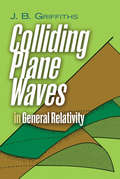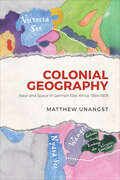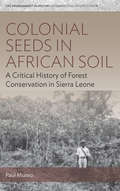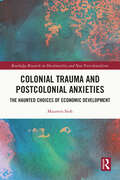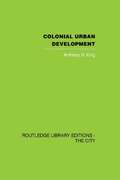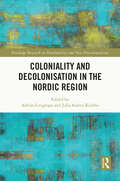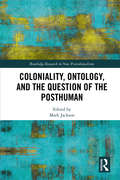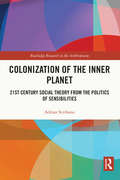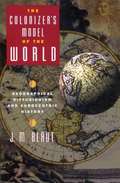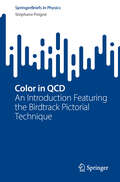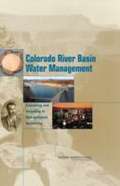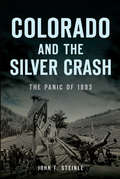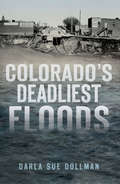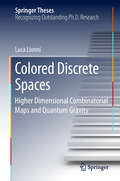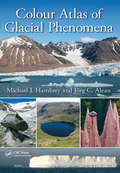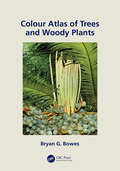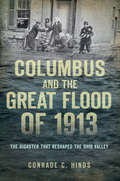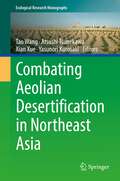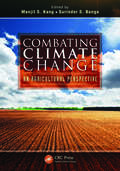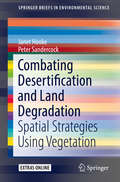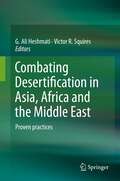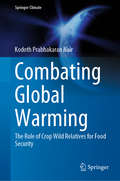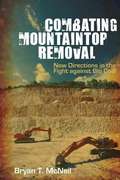- Table View
- List View
Colliding Plane Waves in General Relativity (Dover Books on Physics)
by J. B. GriffithsThis monograph surveys recent research on the collision and interaction of gravitational and electromagnetic waves. "This is a particularly important topic in general relativity," the author notes, "since the theory predicts that there will be a nonlinear interaction between such waves." Geared toward graduate students and researchers in general relativity, the text offers a comprehensive and unified review of the vast literature on the subject.The first eight chapters offer background, presenting the field equations and discussing some qualitative aspects of their solution. Subsequent chapters explore further exact solutions for colliding plane gravitational waves and the collision and interaction of electromagnetic waves. The final chapters summarize all related results for the collision of plane waves of different types and in non-flat backgrounds. A new postscript updates developments since the book's initial 1991 publication.
Colonial Geography: Race and Space in German East Africa, 1884–1905 (German and European Studies)
by Matthew UnangstColonial Geography charts changes in conceptions of the relationship between people and landscapes in mainland Tanzania during the German colonial period. In German minds, colonial development would depend on the relationship between East Africans and the landscape. Colonial Geography argues that the most important element in German imperialism was not its violence but its attempts to apply racial thinking to the mastery and control of space. Utilizing approaches drawn from critical geography, the book argues that the development of a representational space of empire had serious consequences for German colonialism and the population of East Africa. Colonial Geography shows how spatial thinking shaped ideas about race and empire in the period of New Imperialism.
Colonial Seeds in African Soil: A Critical History of Forest Conservation in Sierra Leone (Environment in History: International Perspectives #18)
by Paul Munro“Empire forestry”—the broadly shared forest management practice that emerged in the West in the nineteenth century—may have originated in Europe, but it would eventually reshape the landscapes of colonies around the world. Melding the approaches of environmental history and political ecology, Colonial Seeds in African Soil unravels the complex ways this dynamic played out in twentieth-century colonial Sierra Leone. While giving careful attention to topics such as forest reservation and exploitation, the volume moves beyond conservation practices and discourses, attending to the overlapping social, economic, and political contexts that have shaped approaches to forest management over time.
Colonial Trauma and Postcolonial Anxieties: The Haunted Choices of Economic Development (Routledge Research on Decoloniality and New Postcolonialisms)
by Maureen SiohColonial Trauma and Postcolonial Anxieties argues that economic decisions reflect unconscious anxieties about survival and dignity experienced in a cycle of repeat trauma tracing back to the original trauma of loss in colonialism.Readers will understand how emerging economies evaluate the costs and benefits of key economic policies in the postcolonial era using a psychoanalytical framework.While there are psychoanalytic studies of the economy and finance from a western perspective, there have been no sustained psychoanalytic studies from the perspective of East Asian economies, the fastest growing in the world. Scholars will also find the methodology combining archival research with and field studies, including rare interviews with senior decision-makers useful in their own research since it is rare to find studies of social theory that are empirically rich.This book will be of interest to policymakers and scholars of political economy, international development, human geography, postcolonial studies, psychoanalysis, and area studies (Southeast and East Asia). The book can also be used as a text for graduate and upper level university courses.
Colonial Urban Development: Culture, Social Power and Environment
by Anthony D. KingThe Study focuses on the social and, more especially, the cultural processes governing colonial urban development and develops a theory and methodology to do this. The author demonstrates how the physical and spatial arrangements characterizing urban development are unique products of a particular society, to be understood only in terms of its values, behaviour and institutions and the distribution of social and political power within it. Nowhere is this more apparent than in 'colonial cities' of Asia and Africa where the environmental assumptions of a dominant, industrializing Western power were introduced to largely 'pre-industrial' societies. Anthony King draws his material primarily from these areas, and includes a case study of the development of colonial Delhi from the early nineteenth century to 1947. Yet, as the author explains, the problems of how cultural social and political factors influence the nature of environments and how these in turn affect social processes and behaviour, are of global significance. This book was first published in 1976.
Colonialism, Han, and the Transformative Spirit
by Grace Ji-Sun KimGlobalism, colonialism, and consumerism have caused unjust suffering (han), for the earth's exploited peoples and the exploited lands. To reverse this tragedy, we need to work for a safer, sustainable planet and renew our inspiration from God as the transforming Spirit who gives, sustains and empowers life to all.
Coloniality and Decolonization in the Nordic Region (Routledge Research on Decoloniality and New Postcolonialisms)
by Julia Suárez-Krabbe Adrián GroglopoThis book advances critical discussions about what coloniality, decoloniality, and decolonisation mean and imply in the Nordic region. It brings together analysis of complex realities from the perspectives of the Nordic peoples, a region that is often overlooked in current research, and explores the processes of decolonisation that are taking place in this region. The book offers a variety of perspectives that engage with issues such as Islamic feminism and the progressive left; racialisation and agency among Muslim youths; indigenising distance language education for Sami; extractivism and resistance among the Sami; the Nordic international development endeavour through education; Swedish TV reporting on Venezuela; creolizing subjectivities across Roma and non-Roma worlds and hierarchies; and the whitewashing and sanitisation of decoloniality in the Nordic region. As such, this book extends much of the productive dialogue that has recently occurred internationally in decolonial thinking but also in the areas of critical race theory, whiteness studies, and postcolonial studies to concrete and critical problems in the Nordic region. This should make the book of considerable interest to scholars of history of ideas, anthropology, sociology, cultural studies, postcolonial studies, international development studies, legal sociology, and (intercultural) philosophy with an interest in coloniality and decolonial social change.
Coloniality, Ontology, and the Question of the Posthuman (Routledge Research in New Postcolonialisms)
by Mark JacksonThis book brings together emerging insights from across the humanities and social sciences to highlight how postcolonial studies are being transformed by increasingly influential and radical approaches to nature, matter, subjectivity, human agency, and politics. These include decolonial studies, political ontology, political ecology, indigeneity, and posthumanisms. The book examines how postcolonial perspectives demand of posthumanisms and their often ontological discourses that they reflexively situate their own challenges within the many long histories of decolonised practice. Just as postcolonial research needs to critically engage with radical transitions suggested by the ontological turn and its related posthumanist developments, so too do posthumanisms need to decolonise their conceptual and analytic lenses. The chapters' interdisciplinary analyses are developed through global, critical, and empirical cases that include: city spaces and urbanisms in the Global North and South; food politics and colonial land use; cultural and cosmic representation in film, theatre, and poetry; nation building; the Anthropocene; materiality; the void; pluriversality; and, indigenous world views. Theoretically and conceptually rich, the book proposes new trajectories through which postcolonial and posthuman scholarships can learn from one another and so critically advance.
Colonization of the Inner Planet: 21st Century Social Theory from the Politics of Sensibilities (Routledge Research in the Anthropocene)
by Adrian ScribanoThis book explores the conquest, predation and management of human bodies and emotions by the growing capitalist digital community. It seeks to understand the debate between various forms of the individual, subject, actor, and agent to emerge a social theory vision for the 21st century. The book moves beyond the colonization of the physical world to examine the process of colonization of humans. It focuses on the communication humans have with the world to understand how this impacts their sensibilities. This communication is influenced by technological innovations that enable a process of systematic colonization of human beings as bodies/emotions. This book explores a social theory which will allow us to understand this redefinition of the individual. This enables us to uncover connections between the colonization of the ‘inner planet’ that is the human society, and the dialectic of the person and the politics of their sensibilities. This is explored through the tensions that arise between the forms a person assumes in unequal and diverse cultural contexts and the emotions behind those cultural differences. The book will appeal to academics and postgraduate students of sociology, philosophy and anthropology, as well as psychologists, organizational specialists, linguists, ethnographers, historians, political scientists, administrators and professionals affiliated with NGOs.
Colonizer's Model of the World
by J. M. BlautThis book challenges one of the most pervasive and powerful beliefs of our time concerning world history and world geography. This is the doctrine of European diffusionism, the belief that the rise of Europe to modernity and world dominance is due to some unique European quality of race, environment, culture, mind, or spirit, and that progress for the rest of the world results from the diffusion of European civilization. J.M. Blaut persuasively argues that this doctrine is not grounded in the facts of history and geography, but in the ideology of colonialism. It is the world model which Europeans constructed to explain, justify, and assist their colonial expansion. The book first defines the Eurocentric diffusionist model of the world as one that invents a permanent world core, an "Inside," in which cultural evolution is natural and continuous, and a permanent periphery, and "Outside," in which cultural evolution is mainly an effect of the diffusion of ideas, commodities, settlers, and political control from the core. The ethnohistory of the doctrine is traced from its 16th-century origins, through its efflorescence in the period of classical colonialism, to its present form in theories of economic development, modernization, and new world order. Blaut demonstrates that most "Western" scholarship is to some extent diffusionist and based implicitly in the idea that the world has one permanent center from which culture-changing ideas tend to emanate. Eurocentric diffusionism has shaped our attitudes concerning race and the environment, psychology and society, technology and politics.
Color in QCD: An Introduction Featuring the Birdtrack Pictorial Technique (SpringerBriefs in Physics)
by Stéphane PeignéThis book introduces readers to the fascinating world of quantum chromodynamics (QCD) and quarks and gluons, the elementary constituents of protons, neutrons, and all hadrons. Specifically, it focuses on the color of quarks and gluons, responsible for their mutual interactions via the strong force. The book provides an elementary introduction to the birdtrack technique, which is a powerful tool for addressing the color structure of QCD in a pictorial way. The technique shows how quark and gluon colors are combined and mixed in QCD. The author discusses color conservation, shows how to project on color states of systems of quarks, antiquarks, and gluons, how to derive their color charges. The book is enriched with many exercises integrated in the text to learn by doing.This book is primarily intended for particle physics students, graduates, and researchers working in the field of QCD. However, it requires no specific prerequisites in QCD, so it may also be of interest to students of mathematics, as an illustration of the use of the birdtrack pictorial technique in representation theory.
Colorado River Basin Water Management: Evaluating and Adjusting to Hydroclimatic Variability
by National Research Council of the National AcademiesRecent studies of past climate and streamflow conditions have broadened understanding of long-term water availability in the Colorado River, revealing many periods when streamflow was lower than at any time in the past 100 years of recorded flows. That information, along with two important trends--a rapid increase in urban populations in the West and significant climate warming in the region--will require that water managers prepare for possible reductions in water supplies that cannot be fully averted through traditional means. Colorado River Basin Water Management assesses existing scientific information, including temperature and streamflow records, tree-ring based reconstructions, and climate model projections, and how it relates to Colorado River water supplies and demands, water management, and drought preparedness. The book concludes that successful adjustments to new conditions will entail strong and sustained cooperation among the seven Colorado River basin states and recommends conducting a comprehensive basinwide study of urban water practices that can be used to help improve planning for future droughts and water shortages.
Colorado and the Silver Crash: The Panic of 1893 (Disaster)
by John F. SteinleA catastrophic depression engulfed Colorado in 1893. The government's decision to adopt the gold standard and stop buying silver hit the mining industry like a cave-in. Unemployment reached 90 percent in Leadville, a city built on silver. Strikes by union miners in Cripple Creek and Leadville led to destruction and death. Political parties split along battle lines of gold versus silver. By 1898, the country had begun to recover, but silver mining was never the same. Using firsthand commentary and more than one hundred historic photographs, John Steinle skillfully commemorates the story of Coloradans trapped in the unprecedented social, economic and political conflict of America's first great depression.
Colorado's Mrs. Captain Ellen Jack: Mining Queen of the Rockies
by Jane Bardal"You get off this property." - Capt. Ellen Jack, 1887 Ellen E. Jack backed up her orders with a shotgun as she stood at the entrance to her Black Queen Mine. To profit from the mine, located near Aspen, Colorado, she engaged in many other battles with lawyers and capitalists who tried to wrest her ore away. Mrs. Captain Jack contributed to the myth of the West by crowning herself as the "Mining Queen of the Rockies" as she entertained tourists at her roadhouse near Colorado Springs. Author Jane Bardal offers a captivating biography of a pioneering woman who fashioned a legacy through true tenacity and maybe even a few tall tales.
Colorado’s Deadliest Floods (Disaster)
by Darla Sue DollmanRanked among the top ten states for both disasters and dry climate, Colorado has a long history of extreme weather. On May 19, 1864, residents of the fledgling gold rush town of Denver awoke to a wall of water slamming into the city with enough force to flatten buildings and rip clothing from its victims. The infamous Big Thompson Canyon flood of 1976 killed 144 residents, tourists and campers. Per the National Center for Atmospheric Research, Coloradoans experienced twenty-two floods with contemporary monetary losses of $2 million or more since the flood of 1864. And as the population continues to grow, the loss of lives, property, crops and livestock may increase. Local author Darla Sue Dollman, who witnessed and survived many of the contemporary disasters, examines the state’s most catastrophic flash floods from 1864 to 2013.
Colored Discrete Spaces: Higher Dimensional Combinatorial Maps and Quantum Gravity (Springer Theses)
by Luca LionniThis book provides a number of combinatorial tools that allow a systematic study of very general discrete spaces involved in the context of discrete quantum gravity. In any dimension D, we can discretize Euclidean gravity in the absence of matter over random discrete spaces obtained by gluing families of polytopes together in all possible ways. These spaces are then classified according to their curvature. In D=2, it results in a theory of random discrete spheres, which converge in the continuum limit towards the Brownian sphere, a random fractal space interpreted as a quantum random space-time. In this limit, the continuous Liouville theory of D=2 quantum gravity is recovered. Previous results in higher dimension regarded triangulations, converging towards a continuum random tree, or gluings of simple building blocks of small sizes, for which multi-trace matrix model results are recovered in any even dimension. In this book, the author develops a bijection with stacked two-dimensional discrete surfaces for the most general colored building blocks, and details how it can be used to classify colored discrete spaces according to their curvature. The way in which this combinatorial problem arrises in discrete quantum gravity and random tensor models is discussed in detail.
Colour Atlas of Glacial Phenomena
by Michael J. Hambrey Jürg C. AleanConsidering that glaciers and ice sheets cover about 10% of the Earth’s land surface in a world where human civilization is increasingly impacted by the effects of changing glacial activity, Colour Atlas of Glacial Phenomena presents itself as an indispensable guide for students, professionals, and researchers who want to be better informed while studying and tracking the future influences of glaciers and ice sheets on the global environment. While stressing both the beauty and utility of glaciers, the authors cover critical features of glaciers and their landforms and provide useful explanations of the key concepts in glaciology and glacial geology. The authors expand to demonstrate how our lives are influenced by the Cryosphere, a key component of the Earth system and how this heightens the vulnerability of glaciers and ice sheets to deterioration. This illustrated book also helpfully maps out regions of mountain glaciers and ice caps around the world for a practical reference and discusses the products of glacial erosion and deposition integral to understanding rising global sea levels.
Colour Atlas of Woody Plants and Trees
by Bryan G. BowesTrees and plants are important components of the human environment having significant presence beyond agricultural and recreational values. Colour Atlas of Woody Plants and Trees presents a photographic compilation of morphological features of trees and shrubs giving attention to their unique aspects not presented in existing books. By increasing awareness to users through high quality, full-color photographs and informative text, this book demonstrates the enormous diversity of vascular trees and plants living today. Features: Full color atlas offers concise, but highly informative text accompanied by over 200 high-resolution digital tree images Contains images of the anatomy of tree structures and evolution of the most important features of trees Presents information on the varied structure and morphology exhibited by trees and demonstrates their vital importance in the current struggle for the survival of our human society Surveys the most important morphological features of plants, shrubs and trees Presents aspects of plants and trees both common and rarely seen in nature Bryan Geoffrey Bowes is a retired Senior Lecturer in the Botany Department at Glasgow University and was a Research Fellow in ETH Zurich, Harvard University, and University of New England, Australia. His research interests encompass plant anatomy and ultrastructure, plant regeneration, and morphogenesis in vitro.
Columbus and the Great Flood of 1913: The Disaster that Reshaped the Ohio Valley (Disaster)
by Conrade C. HindsBeginning on Easter Sunday, March 23, 1913, Columbus and the Ohio Valley endured a downpour that would produce the largest flood in one hundred years. Heavy rains came on the heels of an especially cold winter, resulting in a torrent of runoff over saturated and frozen ground. Rivers and streams quickly overflowed and levees failed, sending tsunami-like floodwater into unsuspecting communities and claiming four hundred lives. There were ninety-six deaths in Columbus alone when the swollen Scioto River emptied water that ran nine to seventeen feet deep through the streets of the near west side. Join Conrade C. Hinds and the Columbus Landmarks Foundation in a closer look at a flood disaster that reshaped the American Midwest.
Combating Aeolian Desertification in Northeast Asia (Ecological Research Monographs)
by Tao Wang Atsushi Tsunekawa Xian Xue Yasunori KurosakiThis book presents the definition of aeolian desertification and uncovers its processes, driving factors, and consequences, and focuses on measures to effectively combat aeolian desertification in Northeast Asia. Aeolian desertification in Northeast Asia is of great concern for its destructive influences on the environment and society not only in the local but also in faraway areas. The topics of this book are addressed by compiling theoretical review, remote sensing monitoring, synoptic analysis, and laboratory and field studies in China, Japan, and Mongolia. This is the first comprehensive book to address the aeolian desertification in Northeast Asia. Readers can learn the basic theory of aeolian desertification and the primary causes of this environmental problem. More critical is the successful practical countermeasures to combat desertification which can be referred to by various stakeholders who concern the aeolian desertification in Northeast Asia. To meet the Sustainable Development Goals of the United Nations adopted in 2015, especially its Goal 15.3 to achieve a land degradation-neutral world by 2030, desertification combating actions should be taken cross country borders. This book is not only intended for environmental professionals but also for people who are affected and concerned about desertification and land degradation. The concept and processes in this book will serve as a ready reference to understand the aeolian desertification with countermeasures and successful preventing stories that can be referred to.
Combating Climate Change: An Agricultural Perspective
by Manjit S. Kang Surinder S. BangaThe effects of climate change can already be felt around the world, and they will likely impact all facets of human civilization-from health, livelihood security, agricultural production, and shelter to international trade. Since anthropogenic factors are mainly to blame for the current trends in global warming, human intervention will be necessary
Combating Desertification and Land Degradation: Spatial Strategies Using Vegetation (SpringerBriefs in Environmental Science)
by Janet Hooke Peter SandercockThis book reports an approach developed to research and apply methods of assessing patterns of processes in the landscape, and suitability of different types of vegetation to mitigate soil erosion and sediment flux. Practical guidelines on a spatially strategic approach to management of land degradation at a range of spatial scales were produced. Originally developed for the Mediterranean environment, it has much wider potential global application. It provides researchers with methods to acquire the knowledge necessary for such an approach and provides practitioners with guidance on implementation and benefits of targeted methods of soil erosion control. It includes substantial information about processes and vegetation in the Mediterranean environment and the species effectiveness in soil erosion control.
Combating Desertification in Asia, Africa and the Middle East: Proven practices
by Victor R. Squires G. Ali HeshmatiThis book is about the 'how' of desertification control as opposed to an analysis of the 'why' and fills a gap in the desertification-related literature in that it shows what to do in situations ranging from fixing mobile sands to arresting accelerated soil erosion in sloping lands. There are numerous illustrations to show the successful techniques. This compilation demonstrates that desertification and land degradation can be controlled and reversed with existing techniques in such widely varying environments as the Sahel of Africa to Sri Lanka and the Philippines in SE Asia, from mountains in Lesotho to low lands on desert margins in Mongolia. Proven approaches include technical interventions, changes in governance and to the legislative framework and policy reform. The book fills a gap in the desertification-related literature in that it shows what to do in situations ranging from fixing mobile sands to arresting accelerated soil erosion in sloping lands.
Combating Global Warming: The Role of Crop Wild Relatives for Food Security (Springer Climate)
by Kodoth Prabhakaran NairThis book critically examines the environmental hazards posed by global warming with regard to future food security, which will depend on a combination of stresses, both biotic and abiotic, imposed by climate change; variability of weather within a growing season; and the development of cultivars that are more sensitive to different ambient conditions. Furthermore, the ability to develop effective adaptive strategies which allow these cultivars to express their genetic potential under changing climate conditions will be essential. In turn, the book investigates those plant species which are very closely related to field crops and have the potential to contribute beneficial traits for crop improvement, e.g. resistance to a wide range of biotic and abiotic stresses, enriching the gene pool, and ultimately leading to enhanced plant yield, known as “Crop Wild Relatives” (CWRs). CWRs hold tremendous potential to sustain and enhance global food security, contributing to human well-being. Accordingly, their development, characterization and conservation in crop breeding programs have assumed great practical importance.Professor Kodoth Prabhakaran Nair is an internationally acclaimed agricultural scientist, with over three decades of experience in Europe, Africa and Asia, holding some of the most prestigious academic positions, including the National Chair of the Science Foundation, The Royal Society, Belgium. A Senior Fellow of the world renowned Alexander von Humboldt Research Foundation of The Federal Republic of Germany, he is best known, globally, for having developed a revolutionary soil management technique, known as "The Nutrient Buffer Power Concept", which, while questioning the scientific fallacies of the highly soil extractive farming, euphemistically known as the "green revolution", has opened up an alternative path for sensible and scientific soil management
Combating Mountaintop Removal: New Directions in the Fight against Big Coal
by Bryan T. McNeilDrawing on powerful personal testimonies of the hazards of mountaintop removal in southern West Virginia, Combating Mountaintop Removal critically examines the fierce conflicts over this violent and increasingly prevalent form of strip mining. Bryan T. McNeil documents the changing relationships among the coal industry, communities, environment, and economy from the perspective of local grassroots activist organizations and their broader networks. Focusing on Coal River Mountain Watch (CRMW), an organization composed of individuals who have personal ties to the coal industry in the region, the study reveals a turn away from once-strong traditional labor unions and the emergence of community-based activist organizations. By framing social and moral arguments in terms of the environment, these innovative hybrid movements take advantage of environmentalism's higher profile in contemporary politics. In investigating the local effects of globalization and global economics, McNeil tracks the profound reimagining of social and personal ideas such as identity, history, and landscape and considers their roles in organizing an agenda for progressive community activism.
